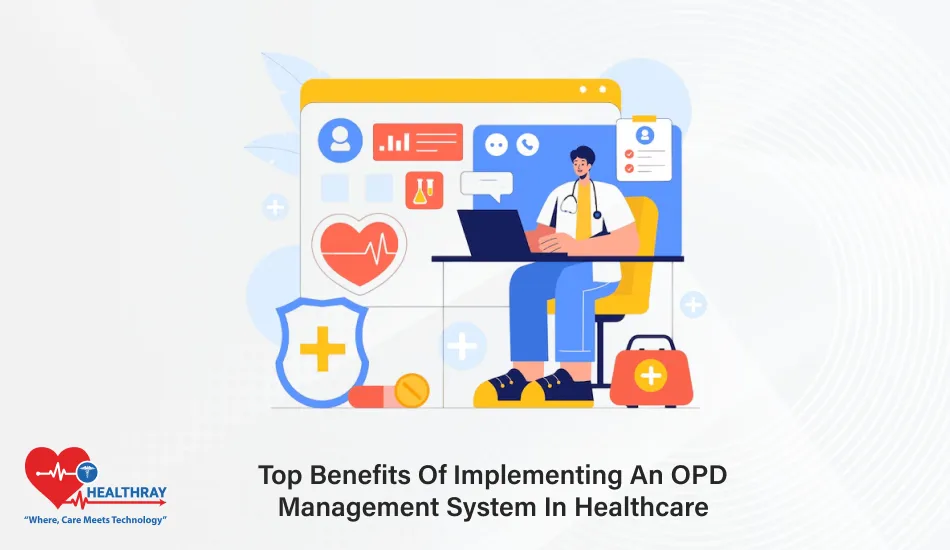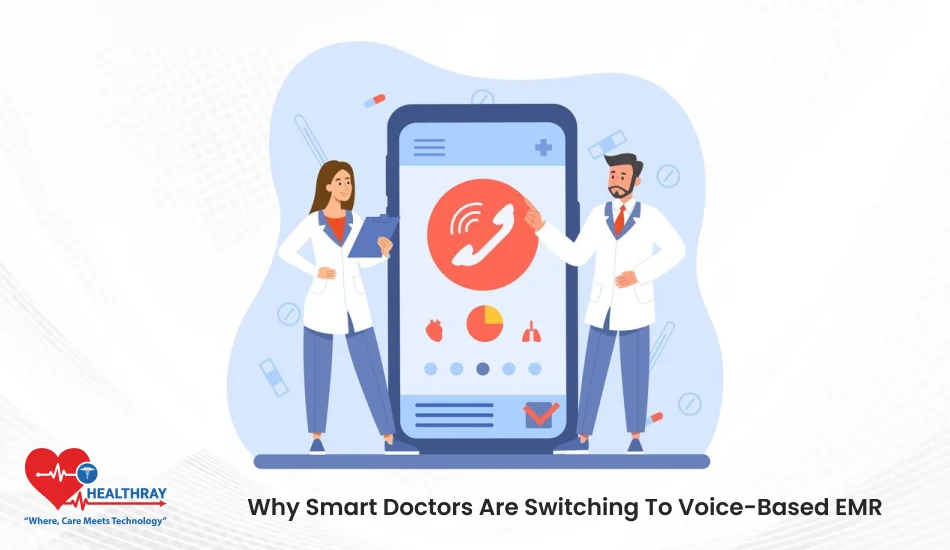No easy task, OPD management includes a lot of work: from patients juggling appointment schedules to patients ensuring with hospital staff that their records are updated; it does not take much for the entire ambivalence to set in. This is where the curses of chaos would be cast by the OPD management system.
An OPD management system is thus a technology-mediated solution that aims to smoothen out these processes, enhance accuracy, and better patient care.
But how is this system making the difference?
Minimizing inefficiencies and enhancing the productivity of operations leaves hospital administrators free to focus on other concerns. For IT managers, this digital solution integrates easily into the existing setup. For the physicians, it ensures they spend more time with patients than on paperwork.
The post describes the top advantages of implementing an OPD management software and provides a case for why it must be included in the upgrade list of services for modern health facilities.
Streamlining Administrative Processes
Managing the day-to-day operations of an outpatient department involves a lot of moving parts. Appointment scheduling, patient registration, and queue management are just a few of those activities that could become real chaos if no systems were in place. An OPD management system streamlines these processes via automation.
Once patients get their appointments scheduled electronically, they themselves can book their slots online or through kiosks without any manual interventions. This would eliminate chances of double booking and reduce errors to a minimum. In registration, patients’ details are captured only once and stored safely, thus minimizing repetitive data entries.
Again, queue management will surely be one of the areas that will benefit immensely here. A queuing system creates a smooth flow through token assignments while updating in real-time on waiting times, alerting patients when their turn is near and thus lessening confusion and complaints.
For hospital administrators, this means less pressure on the staff and happier patients. It further gives a chance to the healthcare team to focus on delivering high-quality care while not wrestling with logistics.
Improving Doctor and Patient Experience
Patients want healthcare to be fast and smooth. Long waits, no or false communication, and faded record keep can ruin their trust in the system. An OPD management system, on the contrary, radically enhances the patient voyage by working on those pain points.
Imagine entering a hospital and knowing exactly how long you would be waiting to see a doctor. Such systems enable an easy appointment scheduling experience along with real-time updates, so the patients can sort out their plans better. The registration process would be quick, since the patient details are already stored, and less paper is required.
Another major benefit comes in the form of clear communication. Patients receive SMS or app alerts for their appointments, documents they should bring, or prescription pick-up notifications. This minimizes confusion to ensure just about everything is tracked by the patient along the way.
For doctors and healthcare staff, instant access to accurate patient records means consultations can be more tailored, grounded, and engaged. It also leaves the patient feeling appreciated rather than merely managed.
A good experience translates into loyalty; the patient is bound to return for further treatment and most importantly refer the facility to others. This kind of loyalty is a boon in the competitive healthcare environment.
Ensures Accurate Patient Records
Accurate records for patient information are the backbone of effective healthcare. Whenever patient information becomes scattered and incomplete, it results in diagnostic errors, delayed treatment, and even endangerment to patient safety. An OPD management system solves these problems by centralizing and digitizing all patient information.
Every little detail, from medical history to diagnostic reports, is safely stored in one secure integrated system, enabling doctors to navigate through the system for even great-grandmothers’ records with a click. Whether it is a follow-up visit or a consultation on an emergency, decision-making has been much better on the basis of the available lucid information.
A converted format means the risk of losing or misreading written notes has been removed. If prescription information is debilitatingly clear, the chances of error in medication dispensing are greatly reduced. Finally, with updated records, the healthcare teams can easily work together to deliver integrated care because every department operates with the same credible information.
From the hospital administration viewpoint, it simply means better compliance with protocols and less hassle with audits. Accurate records provide enhanced facilitation to billing and insurance claims through the significant reduction of discrepancies.
Enhancing Revenue Management
Revenue management of a hospital would, by some sort of analogy, be as tricky as maintaining the quality of care. There are so many financial leakages that could affect the bottom line: missed charges, delays in billing, and human error. Enter the OPD software, ready to fix these glitches with deadly precision.
The system predominantly takes care of billing automatically, ensuring that all patient-care services-rendered are recorded and billed accordingly; such as consultations, diagnostic tests, or procedures. This avoids missing charges or duplicate entries, allowing payments to be processed quicker and the generation of bills detailing the services rendered, which is easier for the patient to understand, increasing transparency.
Monitoring revenue becomes seamless for the hospital administrators. These systems generate comprehensive financial reports that highlight areas of improvement. Whether it’s overdue payments or trends in revenue growth, these reports give administrators manageable information to make sound decisions on maintaining financial health.
Insurance claims management integration is meant to make what so far has been a laborious affair simple. Thanks to correct records and documentation, claims are cleared faster and the hospital receives reimbursement in a timely manner. .
Good revenue management not only gives the financial base of the hospital a certainty but also releases resources that can be reinvested into further clinical services, better equipment, or staff training.
Optimizing Resource Utilization
Setting up a healthcare facility for efficiency is mainly based on resource utilization—staff, rooms, and equipment. If doctors are overbooked, diagnostic tools are underutilized, and patient flow is poorly managed, it can lead to time losses, unwarranted costs, and dissatisfaction among patients.
An OPD management system would optimize these resources by giving a clear overview and intelligent scheduling.For example, the system looks at appointment patterns to ensure that doctors’ schedules are either overloaded or made free with some doctors idle. In this way, diagnostic equipment (for example: MRI machines, X-ray units) is optimally scheduled based on patient needs to avoid bottlenecks and maximize uptime.
Other ways, the system also optimizes the use of waiting areas and consultation rooms. It is capable of real-time tracking of patient flow to pinpoint bottlenecks and act before they develop into bigger problems.
To the benefit of supervisors, these systems also provide resource utilization reports with in-depth analysis showing inefficiencies and areas that need improvement. These issues, which the system highlights, may pertain to staff allocation, room assignments, and equipment utilization; thus providing the foundation for sound decision-making.
Leads to greater operational efficiency, cost savings, and patient and employee satisfaction, which all result from effective resource utilization.
Enhanced Decision-Making Through Analytics
In healthcare, data is not just an option; it is a prerequisite. An OPD management system provides real-time insights to healthcare administrators and doctors for better decision-making. These systems collect data and analyze data from the operations each day, thereby revealing trends and practical insight.
For example, an OPD management system may record patient volumes over time to help administrators anticipate the busy periods and prepare for them. The identification of workflow bottlenecks in delayed diagnostic services or high patient drop-off rates to the improvement plan is another area where it can identify opportunities.
The doctors can also take advantage of the data analysis. By analyzing treatment patterns, patient outcomes, and common symptom sets, refinements to their approaches to care can occur. Ultimately, predictive analytics could highlight a likely complication early on, allowing for preventative measures to be put in place.
The administrator gets insight into the performance of the finances, utilization of resources, and productivity of staff. These can be legitimate parameters for strategic planning or continuous improvement, whether in the areas of hiring more staff, getting new equipment, or changing how things are done.
Data-driven decision-making increases in both operational efficiency and quality of healthcare service provided. It provides a framework, allowing healthcare facilities to foresee certain aspects and quickly adjust for them in a fast-paced environment.
Conclusion
The implementation of the OPD management system is no longer a mere trend but has become an absolute necessity for any modern healthcare institution. These systems target the buildings’ workflows, increase patient satisfaction, guarantee accurate records, and maximize resource utilization. For administrators, it means improved operational efficiency with a fixed margin for financial security. For healthcare IT managers, it is another tool that can be assimilated into existing businesses. For the doctors, it stands as a support system with which to divert focus from paperwork to the more gratifying task of patient care.
An investment in the OPD management system technology is well worth the investment at the healthcare frontier. The OPD management system is an utmost defining factor in catering to the urges of growing patient demands and operational challenges. It is designed for improving day-to-day efficiency or a wonderful patient experience whatever the aim is toward achieving this.





